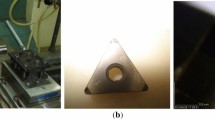Abstract
This paper is the third in a series of work done on a novel technique for bandsawing, which uses a tip-inserted saw, and is gaining increasing popularity in Japan. It builds up on previous reports on the novel technique for bandsawing, which considered cutting tool hardness, tool wear, accuracy of kerf width, washboarding, and surface profiles of the workpiece. In this paper, ash content analysis and three-point static bending tests were conducted to clarify the influence of mineral salts and mechanical properties of wood samples of Elais guineensis (Oil palm), Strombosia glaucescens (Afina), and Cryptomeria japonica (Sugi) on cutting tool wear. The cutting tools were made from Stellite and High Speed Steels (HSS) of designations SUS420J2 and TiN coated SKH 51 according to the Japan Industrial Standards (JIS). Among the tested wood samples, the highest cutting tool edge recession when machining with SUS420J2 and TiN coated SKH 51 tools were recorded in Oil palm in spite of Afina possessing the highest mechanical strength properties. On the contrary, Stellite in spite of possessing the smallest hardness (HV580) among all the tested cutting tools recorded the lowest cutting tool edge recession when machining wood samples of Oil palm. However, Stellite recorded the highest edge recession when machining Afina, a high density species. Ash content analysis and a scanning electron micrograph of wood samples of the tested wood species show the presence of high proportions of mineral salts in the transverse, radial and tangential sections of Oil palm. This could perhaps account for the high cutting tool edge recessions recorded in wood samples of the Oil palm. The studies have demonstrated that silica accumulation species could have significant effect on tool wear of high speed steels.
Zusammenfassung
Dies ist der dritte Teil einer Artikelserie über eine neuartige Bandsägentechnik, bei der ein spitzenverstärktes Sägeblatt eingesetzt wird. Diese Technik gewinnt in Japan zunehmend an Popularität. Dieser Artikel baut auf frühere Berichte auf, in denen Werkzeughärte, Abnutzung, Schnittgenauigkeit, Waschbrettschnitt und Oberflächenqualität des Werkstücks behandelt wurden. In der vorliegenden Untersuchung wurden Aschegehaltanalysen und Drei-Punkt-Biegeversuche an Proben der Holzarten Elais guineensis (Ölpalme), Strombosia glaucescens (Afina) und Cryptomeria japonica (Sicheltanne) durchgeführt, um den Einfluss der mechanischen Eigenschaften dieser Holzarten sowie von eingelagerten Mineralsalzen auf die Sägeblattabnutzung zu ermitteln. Die Werkzeuge bestanden aus Hartmetall (Stellite) und Hochgeschwindigkeitsstahl (HSS) der Arten SUS420J2 und mit TiN beschichtetem SKH51 entsprechend den Japanischen Industrienormen (JIS). Der grösste Verschleiss bei Sägeblättern aus SUS420J2 und TiN beschichtet mit SKH51 trat bei Ölpalme auf, obwohl Afina die höchsten Festigkeitseigenschaften aufwies. Trotz der geringsten Härte (HV580) aller untersuchten Werkzeuge wiesen Hartmetallwerkzeuge den geringsten Verschleiss beim Sägen von Ölpalme auf, wohingegen bei der Bearbeitung von Afina, einer Holzart mit hoher Rohdichte, die stärksten Abnutzungserscheinungen auftraten. Aschegehalt- und REM-Analysen der untersuchten Holzarten zeigten bei Ölpalme in Axial-, Tangential- und Radialschnitten hohe Gehalte an Mineralsalzen. Dies könnte ein Grund für die grosse Abnutzung der Werkzeugschneiden in Ölpalme sein. Die Untersuchungen haben gezeigt, dass Silizium-akkumulierende Holzarten einen signifikanten Einfluss auf den Verschleiss von HSS-Werkzeugen haben können.
Similar content being viewed by others
References
Amos GL (1951) Silica in timbers. Division of Forest Products, Commonwealth Scientific and Industrial Research Organization, Australia
Aragon CT (2000) Coconut program area research planning and utilization. Philippine institute for development studies. Discussion paper series No. 2000-31
British Standard Institution (1957) British Standard 373:1957. Testing small clear specimens of timber, BSI, London
Koch P (1964) Wood machining processes. The Ronald Press Company, pp 74–76
Metten CJ (1986) Structural timber design technology. Longman scientific and technical group, UK, Longman house, Burnt hill, Hallow Essex CM202JE England, pp 16–17
Okai R, Frimpong-Mensah K, Yeboah D (2004) Characterization of strength properties of branchwood and stemwood of some tropical hardwood species. Wood Sci Tech 38(2):163–171
Okai R, Tanaka C, Iwasaki Y (2005) Application of a novel technique for bandsawing using a tip-inserted saw regarding surface profile. Holz Roh- Werkst DOI 10.1007/s00107-005-0023-6
Panshin A, Zeeuw CD (1980) Textbook of wood technology. 4th edn. McGraw-Hill, New York
Stalnaker JJ, Harris EC (1989) Structural design in wood structural engineering series. Van Nostrand Reinhold, 115 5th Avenue, New York, NY 10003, pp 120–127
Tanaka C, Okai R, Iwasaki Y, Sandak J, Ohtani T, Hu C, Iskra P, Xuequn L (2003) Development of a new technology for bandsawing using a tip-inserted saw part 1. Consideration of tool hardness, cutting tool wear and accuracy of kerf width. Forest Prod J (In press)
Author information
Authors and Affiliations
Corresponding author
Rights and permissions
About this article
Cite this article
Okai, R., Tanaka, C. & Iwasaki, Y. Influence of mechanical properties and mineral salts in wood species on tool wear of high-speed steels and stellite-tipped tools – Consideration of tool wear of the newly developed tip-inserted band saw. Holz Roh Werkst 64, 45–52 (2006). https://doi.org/10.1007/s00107-005-0015-6
Published:
Issue Date:
DOI: https://doi.org/10.1007/s00107-005-0015-6




